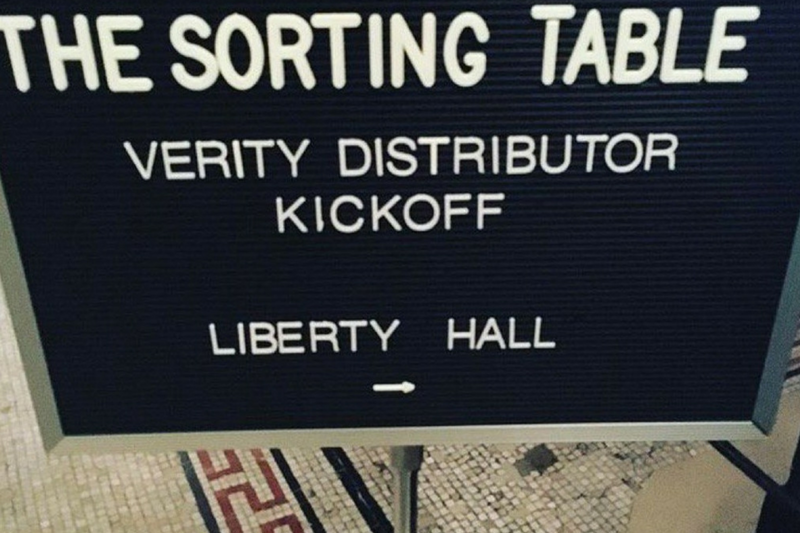Log in to your account
Lost password?Distribution
The Distributor’s Dilemma: Your Checklist And How To Solve One Problem At A Time
It’s helpful to start out by looking at the environment you currently occupy and how pressures become primary motivators directing your business.
03/02/2025

Your import and distribution business, as it exists in a capitalist economic environment will exert pressures on you, causing you to react and develop. How you cope and change with those pressures will determine how well you succeed. It’s helpful to start out by looking at the environment you currently occupy and how those pressures become primary motivators directing your business.
What is your current environment?
You probably operate in a crowded, highly-competitive market and you’re trying to grow and keep your supplier base by distinguishing yourself and gaining the advantage over the competition. At the same time, you’re trying to grow sales in your territory, usually at a rate determined by factors beyond your control. As an owner, you’ve made it your mission to make every supplier happy, even the little guys, while managing crushing goals from you largest suppliers. Fiscal responsibility (and probably your banker or investors) mandate that you keep gross profits up, while supplier pressures are pushing your margins down. Finally, you have to manage that largest repository of unavailable cash, your inventory, while suppliers keep urging you to carry more products.
What are the major forces dominating your world?
Revenue: The reality is that 80% of your revenue comes from 20% of your suppliers. Their key items or brands are the foundation of your company’s sales. But you can’t neglect the other 80% of your brands because they are what makes your portfolio interesting and attractive to customers.
Inventory: Long tail inventories put pressure on your cash flow.
Growth: Organic growth (year over year, “same store” analysis) is a limited path to growth. Only by extreme programming, expanding your sales footprint, or acquiring new brands, can you increase growth beyond your base.
Pricing: You know by gut instinct at what price point every brand will optimize sales and you need to find a way to make a profit regardless of downward price pressures.
Proxies: Over time, decisions are being made which begin serving the needs of your organization rather than those of the customer and are putting unnecessary obstacles in the way of your clients doing business with you. These are called “proxies” and are to be avoided at all costs.

How does this pain look?
It takes many forms, and you may have some or all of them under control. But if you are like most companies in this sector, these are the most common “pain points”:
1. Falling short of company goals
2. Failure to deliver on supplier/sales objectives
3. Staff loses sight of which goals and suppliers, are really important. Instead you….
Focus on squeakiest wheel/last contact.
Manage by fire drill – dealing with emergencies from a position of weakness, late in the game, rather than planning for success from a position of strength
4. Sales staff are overwhelmed by product mix (not always selling best margin products)
5. Customers are overwhelmed by abundance of product choices
6. Productivity is lower than it could/should be – leaving money on the table
7. Salesforce doesn’t have/feel ownership of goals, and results
8. Staff are undertrained, unproductive, not accountable
9. Loose or antiquated systems and processes perpetuate poor performance
10. Deteriorating margins squeeze your profits
11. Increasing inventory loads squeeze your cash flow
What are the symptoms?
You have probably seen some or all of these symptoms in your organization. These should be red flags, leading you to reevaluate your systems and procedures and solve the root problems.
1. Angry suppliers with goals in doubt
2. Angry customers with ambivalent loyalties
Which leads to…..
- Sales pressures resulting in plans foisted on your team, with impossible goals and impossible deadlines.
Which leads to….
- Threats, imprudent incentives, frustration, anger and resentment on the part of the sales professionals and your suppliers.
The worst case is that suppliers eventually leave or pull their business, causing monetary losses that are challenging to replace and take time to do so. Sales staff leave for greener pastures, causing suppliers to doubt your commitment to the market, thereby perpetuating the negative feedback loop.
How does an ideal world look?
Employees are awake, aware and engaged, with lines of communication running unimpeded throughout the organization. Your sales staff owns the results and has a stake in the success or failure of every program. Goals are clear, collaborative and aligned with the goals of the team and the company.
Strong company reputation among customers – managed and maintained by an educated sales force and a competent and helpful customer service organization.
Strong supplier relationships built on mutual trust and shared goals. Supplier partners who won’t want to leave, or will think twice before leaving you or moving to a competing distributor.
What a well-run sales organization looks like:
1. Planning and maintenance versus fire drills and breakdowns. If you’re going to run a successful sales organization, you have to know what you plan to accomplish in yearly, quarterly and monthly buckets. Take those goals and build an action plan for each. Planning to succeed rather than trying not to fail makes you proactive. Action plans are far more successful than re-action plans.
2. Daily coaching, called “performance development” replaces annual/semi-annual reviews. The latest Gallup research emphasizes training and education as an everyday exercise, not an annual retreat. Successful performance development is not just about changing the way annual reviews are conducted. Rather, performance development is about creating a cultural shift in how people work and how they work together. Moving from performance management to performance development requires managers to think of themselves as coaches, not bosses.
3. Cohesive, consistent, processes which serve the customer, not the organization are most important. Amazon’s CEO, Jeff Bezos explains that as a company grows, it becomes easy to rely on the process rather than the result. In that case, the process becomes "the thing,". When that happens, some companies stop looking at outcomes and only consider whether they have followed the process correctly, not whether the desired outcome was achieved. (Extreme example: In 2017, UAL forcibly removed a doctor from the plane in order to make room for four United employees. Everyone followed procedure, to a disastrous end result.)
4. Research, once again, shows that individuals and teams perform better when an employee is responsible for both individual and team goals. Therefore, the work individuals perform and goals they pursue should align with the purpose and goals of their team and organization. Employees need to understand their company’s strategy and values, so they can see a connection between their performance and the company’s success. A shared, comprehensive sales and marketing calendar; in a single, visible place, where sales reps can see the company’s top priorities and programs from top to bottom for every quarter and every month is essential.
5. Give everyone in the organization the responsibility and authority to solve customer problems. Tasking employees with following procedures should always be paired with an end result which fulfills their department’s mission statement. The best organizations follow procedure 90% of the time. The other 10% of the time, employees are empowered to “break the rules” in order to evince a positive outcome for the customer.
6. Enlist your supplier partners to participate in the negotiation and fulfillment of goals. What are they asking for? Is it reasonable? Is there a timetable? What do they bring to the table to help you achieve their goals? Outline what your organization will bring. Insist on a customized, written, marketing plan for each supplier detailing the goals and objectives.
7. Brand Management, Sales Management, and Marketing should all have a seat at the table when negotiating goals. Have accounting and logistics sign off, to secure that the back of the house can support the goals. Resist the idea that one department can speak for all of the stakeholders. Integration of the process is key to success.
8. Turn supplier goals into executable sales plans. Manage the supply chain, plan for inventory, understand GP, GM, devise pricing and incentives, evaluate the likelihood of successes or failures in sales, sign off on objectives, fit them into the overall marketing plan and troubleshoot the calendar conflicts.
9. Successful sales goals are bottom up. If field reps participate in the process, then they will own the results. Set “SMART” Goals (Specific, Measurable, Achievable, Realistic, Time-Specific). Hold people accountable - establish, track, reward and recognize performance. Always provide up-to-the-minute tracking and reporting.
10. Training and education distinguish top performers. Sales and execution require that the sales team are on top of their game, know how to prioritize their work, time and territory.
11. Back to the supplier. Proactively set up supplier review meetings in advance of seasonal and structural deadlines. Standardize the reporting and analysis for every supplier meeting so that all data points are covered all questions are answered.
 Contributed by Bill Sciambi, Co-Founder, and Chairman of the Board, Verity Wine Partners. Bill also be presenting at the upcoming BTN’s conference (ABID) for Importers and Distributors in NYC on May 15th. Check out the full schedule here.
Contributed by Bill Sciambi, Co-Founder, and Chairman of the Board, Verity Wine Partners. Bill also be presenting at the upcoming BTN’s conference (ABID) for Importers and Distributors in NYC on May 15th. Check out the full schedule here.
Your import and distribution business, as it exists in a capitalist economic environment will exert pressures on you, causing you to react and develop. How you cope and change with those pressures will determine how well you succeed. It’s helpful to start out by looking at the environment you currently occupy and how those pressures become primary motivators directing your business.
What is your current environment?
You probably operate in a crowded, highly-competitive market and you’re trying to grow and keep your supplier base by distinguishing yourself and gaining the advantage over the competition. At the same time, you’re trying to grow sales in your territory, usually at a rate determined by factors beyond your control. As an owner, you’ve made it your mission to make every supplier happy, even the little guys, while managing crushing goals from you largest suppliers. Fiscal responsibility (and probably your banker or investors) mandate that you keep gross profits up, while supplier pressures are pushing your margins down. Finally, you have to manage that largest repository of unavailable cash, your inventory, while suppliers keep urging you to carry more products.
















